Cameras Statistics By Market Size, Type and Facts

Updated · Mar 11, 2025


TABLE OF CONTENTS
- Introduction
- Editor’s Choice
- Facts About Cameras
- General Statistics
- Digital Camera Statistics
- Surveillance Camera Statistics
- Film Camera Statistics
- GigE Camera Statistics
- Medical Camera Statistics
- 3D Camera Statistics
- Instant Camera Statistics
- Action Camera Statistics
- IP Camera Statistics
- Intraoral Camera Statistics
- Wearable Camera Statistics
- Mirrorless Camera Statistics
- Underwater Fishing Cameras Statistics
- A.I. Camera Industry Statistics
- Interchangeable-lens Cameras (ILCs) Statistics
- Camera Lenses Statistics
- Photography Statistics
- World Camera Shipment Statistics
- Some Future Analyses of Cameras
- Market Share Distribution Statistics
- Conclusion
Introduction
Cameras Statistics: Cameras are an important part of modern life, used for photography, security, and communication. Over the years, camera technology has improved greatly, leading to better image quality, faster performance, and new features like artificial intelligence. Statistics show that billions of photos are taken daily, especially with smartphones, which now dominate the market.
Digital cameras, including DSLRs and mirrorless models, are still popular among professionals. Security cameras are also increasing in number, helping to monitor homes, businesses, and public spaces. People around the world share photos and videos on social media, which has increased the need for cameras. With new technology, cameras keep improving, becoming stronger, easier to use, and a bigger part of daily life.
Editor’s Choice
- The global digital camera market was worth about USD 8.04 billion in 2023. Experts predict it will grow to around USD 12.45 billion by 2032, with an average annual growth rate of 5.06% from 2024 to 2032.
- As mentioned in Camera Statistics, the global, digital camera market is expected to generate revenues of USD 24.4 billion in 2025.
- The average price of a digital camera is expected to remain relatively stable, with an average cost of USD 190 in 2023.
- In 2023, Canon dominated the global digital camera market, accounting for nearly half of the market share, followed by Sony with 26% and Nikon with 12%.
- The global action camera market was valued at USD 3.06 billion in 2024 and is expected to reach approximately USD 6.81 billion by 2034, growing at a CAGR of 8.28% from 2025 to 2034.
- IP Cameras: The global IP camera market size was estimated at USD 14.94 billion in 2024 and is projected to reach around USD 43.62 billion by 2034, with a CAGR of 11.31%.
- China uses 54% of all public video cameras globally as of 2024.
- In London, about 6.27 million cameras are in use for 9.3 million residents in 2024.
- In 2023, the United States earned USD 14.9 billion from camera and film wholesaling, showing a 3.6% growth over the past five years.
- China, Vietnam, and South Korea are the main countries where cameras are imported, and they are also exported to India and Vietnam.
- Advancements in artificial intelligence, high-resolution sensors, low-light performance, and computational photography are driving the digital camera market’s growth.
You May Also Like To Read
- Fitness Trackers Statistics
- Tablets Statistics
- Drones Statistics
- Foldable Smartphones Statistics
- Sleep Tracker Statistics
- Tablet Statistics
- Smart Home Statistics
- Dashboard Camera Statistics
Facts About Cameras
- Do you know who has the most extensive camera collection in the world? A photojournalist from Mumbai named Dilish Parekh owns around 4425 cameras to date.
- In 1975, the first digital camera was invented by Steven Sasson.
- In 1994, Apple released the consumer digital camera.
- In the year 1962, cameras first went into space.
- In 1838, the first photograph of 2 men standing on a street in Louis Daguerre was taken accidentally.
- The first selfie was invented in 1839 by Robert Cornelius.
- As of 2024, people regularly capture almost 4.7 billion photos each day approximately.
General Statistics
- The global market for CCTV cameras is predicted to be USD 2.46 billion by the end of 2031 and to register a CAGR of 10% from 2024 to 2031.
- The traffic camera market is predicted to approach a growth rate of 8% CAGR from 2020 to 2027.
- The worldwide camera lens market is expected to reach above USD 4.42 billion from 2021 to 2025, with an 8% CAGR.
- The global market valuation of film cameras will reach above USD 312.55 million by 2029 and is expected to grow at a CAGR of 3.74% from 2022 to 2029.
- The demand for global medical cameras has increased enormously in recent years, and the North American region dominates the globe with a 50% share. The expected market valuation will reach USD 5 billion by 2031.
Digital Camera Statistics
- A report published by Statista shows that the global digital camera market is expected to generate USD 24.4 billion in revenue by 2025.
- From 2025 to 2029, the market is projected to grow at an annual rate of 1.46%.
- Among all countries, China is expected to lead with the highest revenue, reaching USD 6.3 billion in 2025.
- On an individual level, the market is predicted to bring in USD 3.12 per person that year.
- Looking ahead, the number of digital cameras sold is estimated to reach 135.1 million units by 2029.
- In 2026, sales volume is expected to grow by 1.1%.
By Leading Manufacturers
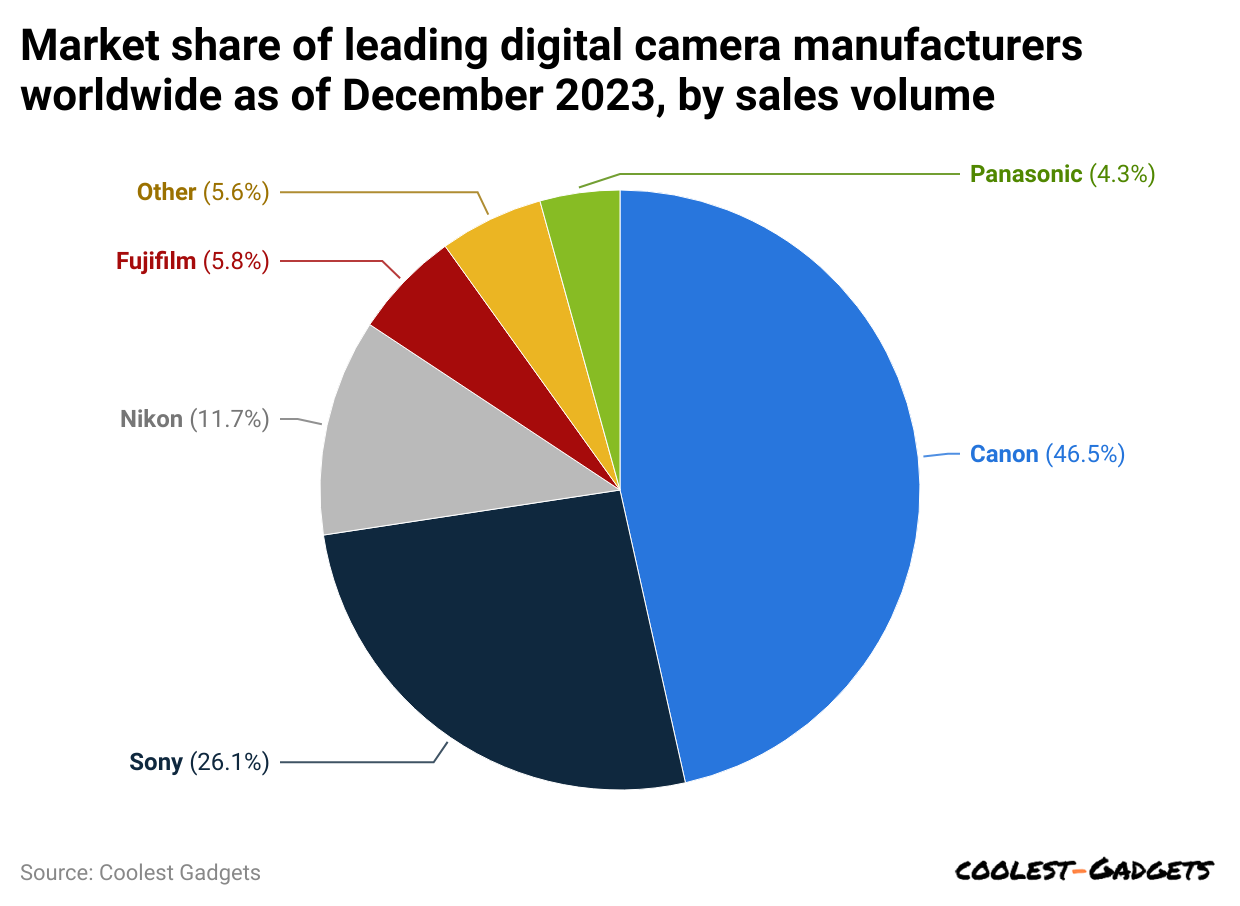
(Reference: statista.com)
- Cameras Statistics of 2024 stated that Canon holds the largest share of the global digital camera market at 46.5%.
- Sony comes next with 27.9%, followed by Nikon at 11.3%.
- Fujifilm controls 6% of the market, while Panasonic holds a smaller share of 3.6%.
Surveillance Camera Statistics
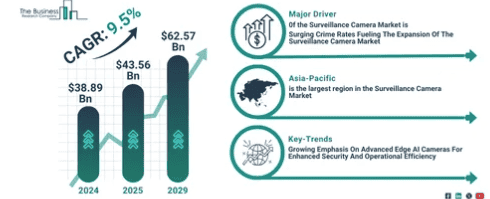 (Source: blog.tbrc.info)
(Source: blog.tbrc.info)
- The global surveillance camera market is projected to grow from USD 38.89 billion in 2024 to USD 43.56 billion in 2025, reflecting a compound annual growth rate (CAGR) of 12.0%.
- Revenue in the smart security cameras segment is expected to reach USD 17.2 billion by 2025, with an annual growth rate of 8.84% from 2025 to 2029.
- For instance, car parking lots equipped with CCTV systems have experienced a 51% reduction in criminal incidents.
- As of 2023, China has an extensive surveillance network, with estimates ranging between 540 to 626 million cameras installed nationwide.
- In India, cities like Hyderabad and Delhi have approximately 900,000 and 450,000 surveillance cameras, respectively.
- China leads the world in public surveillance, hosting 54% of all public video cameras globally.
- The United States saw a 50% drop in crime rates following the installation of CCTV cameras.
- In Taiyuan, China, there are 465,255 surveillance cameras.
- By 2024, Hyderabad and Chennai are expected to have about 3 million and 2.8 million public CCTV cameras, respectively.
- Baghdad, Iraq, monitors the city with 1.2 million cameras and ranks 25th among the most surveilled countries.
- Moscow has 193,000 CCTV cameras, while Saint Petersburg has 55,064.
- Singapore uses 90,000 surveillance cameras.
- Sydney operates 60,000 cameras for public surveillance.
- Istanbul is equipped with 109,000 CCTV cameras.
- Los Angeles and New York City have 22,678 and 31,490 public surveillance cameras, respectively.
- Bangkok has a surveillance network of 57,770 cameras.
Film Camera Statistics
- The global film photography camera market was valued at approximately USD 30.75 billion in 2024.
- North America held a significant market share of 36.56% in 2023, with projections indicating an incremental market value gain of USD 176.05 million and a CAGR of 4.28% between 2024 and 2031.
- In 2023, reusable film cameras dominated the market, accounting for 97.93% of the share, valued at USD 1,322.48 million.
- Amateur photographers represented the largest market segment in 2023, holding 42.65% of the share and having a market value of USD 576.02 million.
- In 2023, the worldwide revenue from film cameras reached USD 277.91 million.
- Experts predict that by 2030, the market value of film cameras will increase to USD 387.27 million, following a consistent annual growth rate of 5.2% starting in 2024.
- By 2029, the market value is expected to hit USD 312.55 million.
- In North America alone, the film camera market size is projected to reach USD 97.91 million by 2029.
- Revenue from 35mm film cameras will total USD 117.50 million by the end of 2029.
- Personal use of film cameras is anticipated to generate USD 64.52 million in revenue by 2029.
- Revenue through direct sales channels is forecasted to be USD 199.76 million by 2029.
GigE Camera Statistics
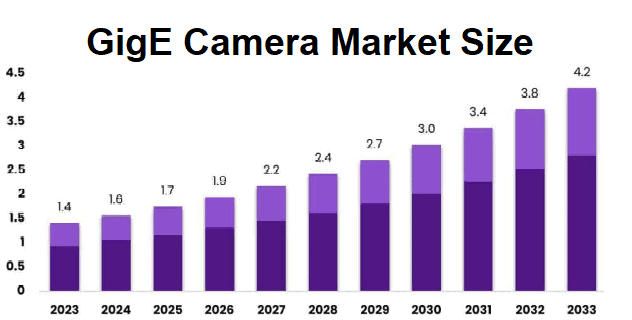 (Source: shortpixel.ai)
(Source: shortpixel.ai)
- In 2024, the global GigE camera market was valued at approximately USD 1.6 billion.
- The market is projected to grow to USD 1.7 billion by 2025.
- The market will expand at a Compound Annual Growth Rate (CAGR) of 11.6% from 2025 to 2033, reaching USD 4.2 billion by 2033.
- GigE cameras, which use Gigabit Ethernet technology to transfer images quickly over long distances, are widely used in industries for automation, quality control, and traffic monitoring.
- North America held a dominant position in the GigE Camera Market, capturing 36.4% of the market share and generating revenue of USD 0.50 billion in 2023.
- The market for GigE cameras is expanding due to increased automation in manufacturing and the need for high-speed cameras in smart transportation systems.
- These cameras are increasingly vital in automation, security, and transportation industries because they can handle high-resolution video streaming with minimal delays.
- Entry-level GigE cameras are becoming more affordable, starting around USD 265, making this technology accessible to a wider range of businesses.
- In 2023, area scan cameras were the most popular type of GigE camera, making up over 67% of this market segment.
- CMOS technology, used for image capturing in cameras, dominated the technology segment of the market with over 69.5% share in 2023.
- The industrial sector was the largest application area for GigE cameras in 2023, accounting for more than 37.1% of the market.
- GigE cameras now support various GigE Vision specifications, including the most recent versions, ensuring they remain compatible with future updates in technology.
Medical Camera Statistics
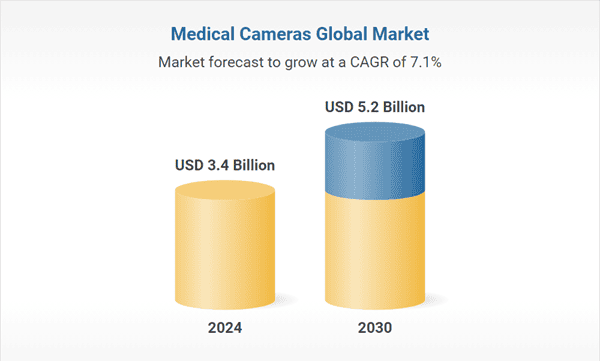 (Source: globenewswire.com)
(Source: globenewswire.com)
- The global medical camera market has reached USD 3.4 billion in 2024 and will make up USD 5.2 billion by 2030, expanding at a rate of 7.1% CAGR. Thee North American region captured the largest share of the global medical cameras market with 40.2% in 2024.
- The Asia-Pacific region is projected to experience the fastest growth rate, with a CAGR of 8.1% from 2024 to 2030.
- Endoscopy Cameras captured the largest market share in 2024, accounting for approximately 30.5%.
- Sensor Technology: Complementary Metal-Oxide-Semiconductor (CMOS) sensors are expected to dominate the market in 2024, capturing an estimated 62.3% share due to their low power consumption
- Resolution Preference: High-Definition (HD) medical cameras are projected to hold a majority share of 66.2% in 2024.
- The global medical camera market is projected to grow from USD 3.1 billion in 2023 to USD 6.4 billion by 2033, expanding at a rate of 7.5% annually.
- North America is the top market, with Europe and Asia-Pacific following due to strong healthcare funding and advanced technology.
- AI and HD imaging help make medical tests and surgeries more accurate and efficient.
- More people want safer, quick-recovery surgeries, increasing the need for medical cameras.
- Regulations by bodies like the FDA in the U.S. and CE in Europe ensure medical cameras meet high safety and quality standards, though they also make market entry challenging.
- AI-enhanced medical cameras are becoming more popular, expected to grow in usage by 40% over the next five years, improving diagnostic precision and surgical outcomes.
- There’s a rising trend in the market for companies to merge or partner, aiming to integrate advanced technologies like AI and surgical robotics to improve the capabilities of medical cameras.
- Hospitals are the primary users of medical cameras, relying on them extensively for various medical applications and procedures.
- CMOS sensors, known for their high-quality imaging and cost-effectiveness, are preferred in over 77% of medical cameras.
3D Camera Statistics
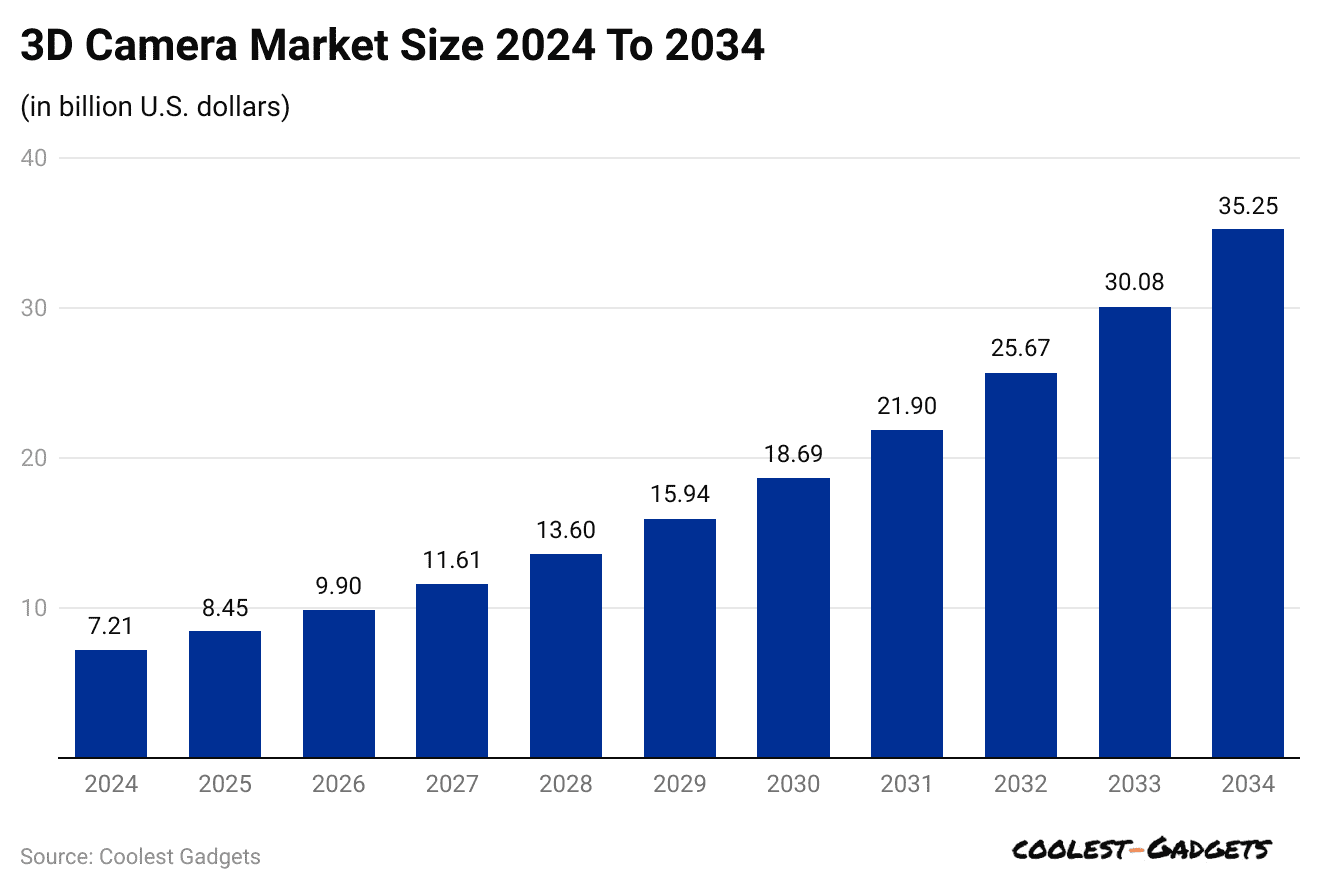 (Reference: precedenceresearch.com)
(Reference: precedenceresearch.com)
- The global 3D camera market is projected to reach approximately USD 7.21 billion in 2024 and is expected to grow to around USD 8.45 billion by 2025.
- A compound annual growth rate (CAGR) of 17.20% is anticipated from 2025 to 2034.
- The Asia Pacific region is expected to dominate the market, with a projected market size of USD 2.96 billion in 2025, growing at a CAGR of 17.37% during the forecast period.
- A 3D camera captures images and videos in three dimensions, enhancing depth perception for a more immersive visual experience.
- This market growth is driven by the demand for improved visual quality in smartphones, tablets, and digital cameras.
- The Asia Pacific region is leading in the 3D camera market, holding 38.2% of the global market share, due to strong manufacturing capabilities and quick adoption of 3D imaging technologies.
- Stereo vision cameras are the most popular type, making up 64.9% of the market share in 2023.
- 3D cameras are widely used in various applications including 3D modeling, augmented and virtual reality, visual effects in post-production, and facial recognition.
- Major companies like Sony Corporation, Fujifilm Holdings Corporation, and Samsung Electronics Co., Ltd. are key players in the 3D camera market.
- Emerging trends in the 3D camera sector include depth sensing for photography and the integration of LiDAR technology.
Instant Camera Statistics
- Cameras Statistics also shows that the global instant print camera market was valued at approximately USD 1.65 billion in 2024.
- The market is expected to reach around USD 1.84 billion by 2025.
- A compound annual growth rate (CAGR) of about 7.9% is anticipated from 2025 to 2033.
- The Asia-Pacific region is a significant contributor, accounting for more than 40% of global sales, with countries like Japan, South Korea, and China leading the market.
- As of 2028, the market size of instant cameras will reach USD 1,605.11 million.
- Some of the best instant cameras of 2024 are Fujifilm Instax Mini 12, Fujifilm Instax Mini Evo, Kodax Mini Shot 3 Retro, and Polaroid Go.
Action Camera Statistics
- The global action camera market was valued at approximately USD 5.02 billion in 2024.
- The market is expected to grow to USD 5.49 billion by 2025, indicating a compound annual growth rate (CAGR) of 8.9%.
- Ultra HD resolution leads the market because it offers high-quality images and videos, driving strong demand in sectors like broadcasting and filmmaking.
- Action cameras are typically used for sports and recreational activities because they can be mounted on helmets, vehicles, or used handheld to record high-definition, wide-angle videos.
- Customers like to see action cameras in person before buying, which helps retail stores sell more.
- In North America, these cameras are very popular because people have higher incomes and enjoy adventure sports. This demand has increased sales of high-quality action cameras in the region.
- In Europe, new product launches focus on enhancing video recording capabilities with wide-angle lenses.
- Online sales are increasing due to attractive website presentations and promotions like holiday sales, which influence new buyers and boost market growth.
- The sports segment dominates the market usage of action cameras, driven by an increase in adventure sports and media coverage.
IP Camera Statistics
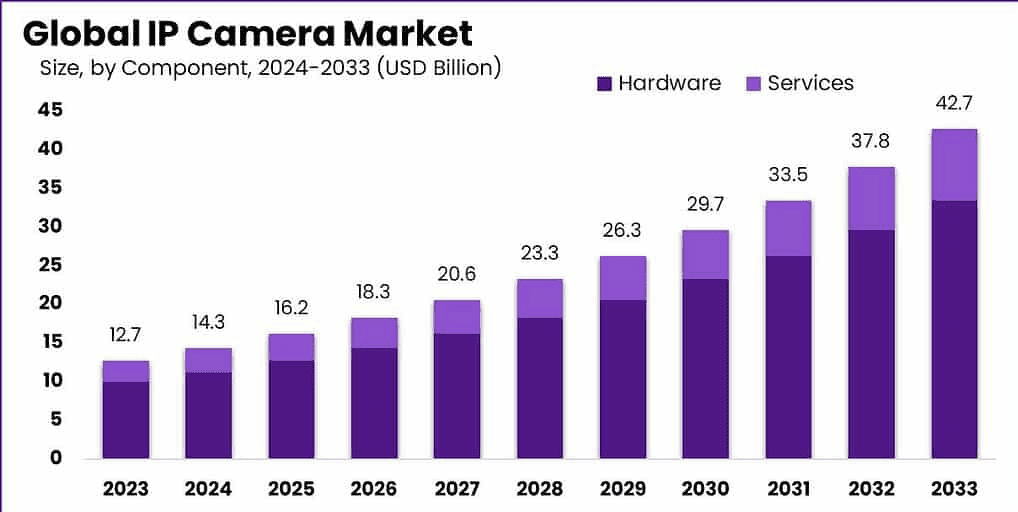 (Source: market.us)
(Source: market.us)
- The global IP camera market is anticipated to grow from USD 14.3 billion in 2024 to USD 16.2 billion in 2025.
- The global IP camera market is anticipated to grow USD 42.7 billion by 2033, with a yearly growth rate of 12.9% from 2024 to 2033.
- IP cameras, also known as Internet Protocol cameras, use digital technology to send video over a network, allowing remote viewing via the internet.
- The majority of the market in 2023 was dominated by the hardware segment, which accounted for 78.4%.
- Fixed IP cameras were the most prevalent type in 2023, making up 44.7% of the market.
- Most IP cameras in 2023 were used for commercial purposes, which represented 63% of the market.
- The Asia-Pacific region was the largest market for IP cameras in 2023, holding 48.9% of the global market.
- Growth in the IP camera market is driven by their integration into smart home and city projects, enhancing security through remote monitoring capabilities.
You May Also Like To Read
- Smart Video Doorbell Statistics
- Wireless Gaming Mouse Statistics
- Electric Kettle Statistics
- Leaf Blower Statistics
- Zero Turn Mower Statistics
- Android TV Box Statistics
- Video Doorbells
- 360 Camera Statistics
- Portable Power Bank Statistics
- Bose Corporation Statistics
- Smartphone Sales Statistics
- Portable Printer Statistics
Intraoral Camera Statistics
- The global market for intraoral cameras is expected to grow significantly, reaching an estimated value of USD 6.0 billion by 2033, up from USD 2.1 billion in 2023. This growth represents an annual increase of 11.1%.
- North America leads the market, generating USD 0.764 billion in revenue in 2023, which is 36.3% of the global total.
- Dental clinics are the primary users of intraoral cameras, accounting for 80.2% of the market’s revenue in 2023.
- The fiber optic camera is the most popular technology in the market, making up 38.1% of the revenue in 2023.
- The intraoral wand is the most common product type, dominating the market with 72.1% of the revenue in 2023.
- Intraoral cameras are becoming more essential due to an increase in dental disorders like tooth decay and dental caries, which drives up the demand for dental visits and related equipment.
- Government support and rising awareness about dental health are boosting the adoption of dental treatments, which in turn increases the demand for intraoral cameras.
- Technological advancements have led to smaller, easier-to-use, and more affordable intraoral cameras, with prices as low as USD 5,000, down from the traditional cost of about USD 40,000.
Wearable Camera Statistics
- As of 2023, the market for wearable cameras has reached USD 7.5 billion and is expected to grow to USD 28 billion by 2033.
- The growth rate of the global market will project a 14% CAGR from 2023 to 2033.
- The largest share was accounted for by the North American region, with 50% of the worldwide market.
- The head-mounted wearable has recorded a 60% global share based on category.
- Sports and fitness applications held around 50% share in 2023.
Mirrorless Camera Statistics
- According to the Industry ARC report analysis, the market is expected to grow at a CAGR of 4.7% from 2023 to 2030.
- In the above forecasted period, the Asia Pacific region will make the highest growth rate with a CAGR of 5.1%.
- It has been predicted that by the end of 2025, these cameras will capture nearly 2 trillion photos.
- The sensor-based stabilization camera dominated with a market size of $0.83 billion in 2023.
- The market share of mirrorless cameras is divided by region: Asia Pacific (51%), North America (23%), Europe (16%), South America (6%), and the rest of the world (4%).
Underwater Fishing Cameras Statistics
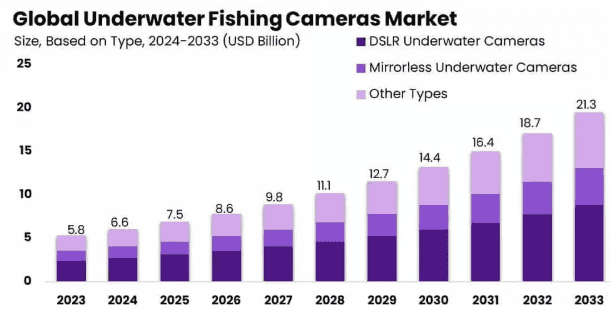 (Source: market.us)
(Source: market.us)
- The global underwater fishing cameras market is projected to reach from USD 5.8 billion in 2023 to USD 21.3 billion by 2033, with a compound annual growth rate (CAGR) of 13.9% from 2024 to 2033.
- The commercial application segment accounted for 50.1% of the market share in 2023.
- Underwater fishing cameras are designed to be waterproof and are used below the water surface to take pictures and videos of fish.
- These cameras come equipped with features like LED lights for better visibility underwater and the ability to capture high-resolution images and videos.
- They are increasingly used in commercial settings, including film production, documentaries, underwater sports, and educational and research activities, to record underwater scenes.
A.I. Camera Industry Statistics
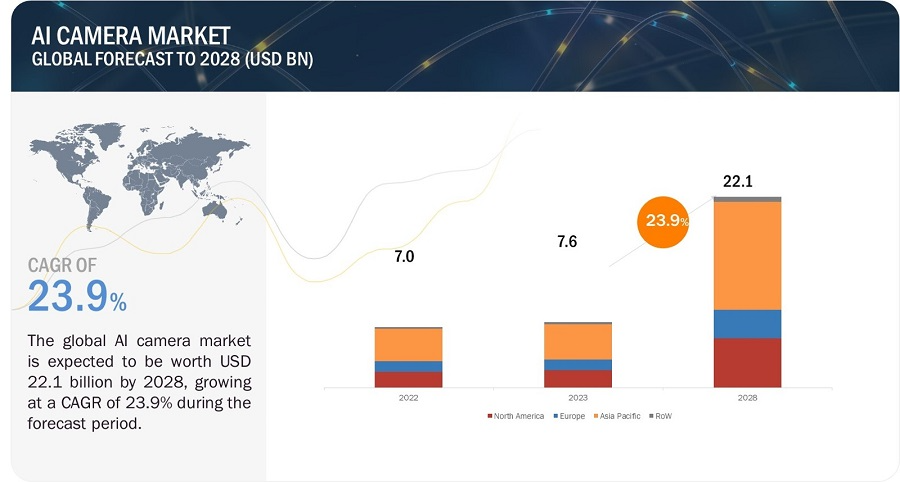
(Source: marketsandmarkets.com)
- In 2023, the A.I. camera industry will have experienced huge growth worldwide, with around USD 7.6 billion
- The market will exceed USD 22.1 billion by the end of 2028, and the average growth rate will be 23.9% from 2023 to 2028.
- As of 2023, the Asia Pacific region has captured the highest market share.
Interchangeable-lens Cameras (ILCs) Statistics
- The global ILC market was valued at approximately USD 20.9 billion in 2024 and is projected to reach USD 21.6 billion in 2025, growing at a CAGR of 3.7% through 2037.
- In 2024, Canon maintained its position as the global leader in the digital camera market, marking its 22nd consecutive year at the top.
- As of 2023, Canon held nearly 50% of the global digital camera market, followed by Sony with 26% and Nikon with 12%.
- Mirrorless cameras are outperforming DSLRs in sales, with a widening gap in shipped units. In one year, DSLR shipments decreased from 2.4 million units to 2.1 million, while mirrorless camera shipments rose from 2.9 million to 3.1 million.
Camera Lenses Statistics
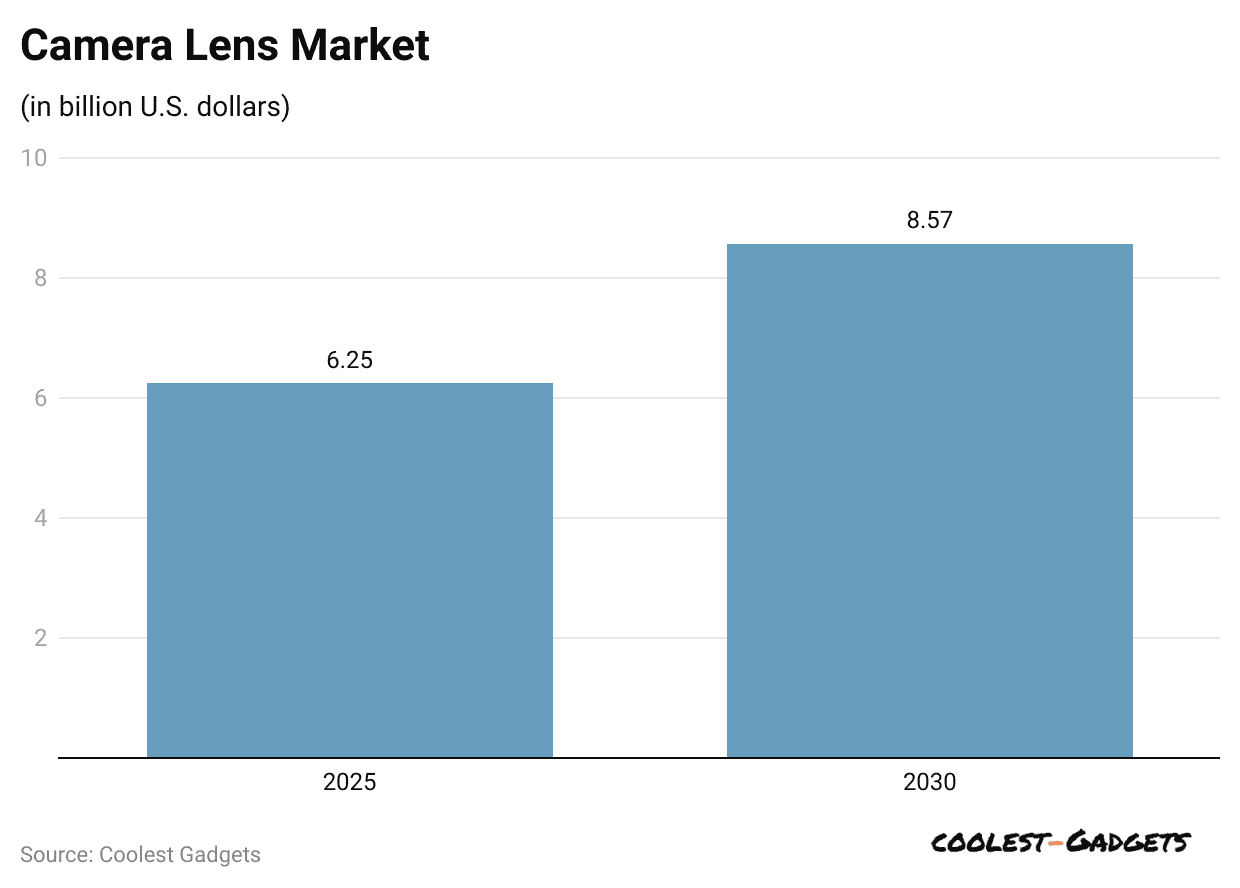 (Reference: mordorintelligence.com)
(Reference: mordorintelligence.com)
- The global camera lens market is projected to reach approximately USD 6.25 billion in 2025.
- From 2025 to 2030, the market is expected to grow at a compound annual growth rate (CAGR) of 6.5%, reaching around USD 8.57 billion by 2030.
- In 2025, shipments of interchangeable camera lenses are forecasted to be 10.56 million units, reflecting a 2.4% year-over-year increase.
- The machine vision camera lenses market is anticipated to expand at a CAGR of 8.80% from 2023 to 2030.
- The secondhand camera lens market is projected to reach USD 4.1 billion by 2032, with a CAGR of 5.8% during the period 2024-2032.
- Last year, camera manufacturers shipped over 9.5 million interchangeable lenses, as reported by the Camera & Imaging Products Association (CIPA).
Photography Statistics
- In 2024, approximately 1.94 trillion photos were taken worldwide, averaging about 5.3 billion photos daily. This number is expected to surpass 2 trillion in 2025.
- Smartphones accounted for 94% of all photos taken in 2024.
- Asia-Pacific residents captured 2.42 billion photos daily in 2024, averaging 0.49 photos per person per day.
- In the United States, individuals took an average of 1.41 photos per person per day, totaling 576 million photos daily.
- Drone Photography Market: The global drone photography services market was valued at USD 733.1 million in 2024 and is projected to grow at a compound annual growth rate (CAGR) of 18.7%, reaching USD 4.07 billion by 2034.
- Photo Editing Software Market: Valued at USD 449.2 million in 2023, the global photo editing software market is expected to grow at a CAGR of 7.7%, reaching USD 886.2 million by 2032.
- Physical Photo Prints: In 2025, 43% of Generation Z individuals (ages 18-27) regularly printed digital photos, compared to just 5% of Baby Boomers (ages 60-78).
- Portrait Orientation Trend: Portrait-oriented photos neared 50% of all images delivered in 2024.
- The photography industry in the U.S. includes over 12,458 companies.
- In the last year, the value of the photography industry reached over USD 36 billion.
- It is predicted that by 2023, 93% of all photos will be taken on iPhones or Android phones, up from 89% in 2020.
World Camera Shipment Statistics
- The import and export shipment of cameras worldwide was 7.3 million in 2023, with 129638 buyers and 97789 suppliers.
- The top 3 global import shipment units of cameras are India (2,066,263), Vietnam (1,645,151), and South Korea (337,652).
- The top 3 global export shipment units of cameras are China (2,308,665), Vietnam (1,150,396), and South Korea (500,483).
- The United States (27168), India (16389), Vietnam (13492), the Philippines (4650), and Turkey (3300) are the camera buyer’s shipment units.
- Camera supplier’s shipment units are China (30996), India (7532), the United States (6715), Vietnam (6617), and Japan (3763).
Some Future Analyses of Cameras
- The market size of camera technology will reach around USD 25.3 billion by 2032, and the growth rate will result in a 12% CAGR from 2022 to 2032.
- Similarly, the smart camera market is supposed to reach USD 1.93 billion by 2033, with a CAGR of 26.1% in the above forecasted year.
- The market demand for security cameras was valued at USD 3.1 billion in 2023 and is expected to surpass USD 6.5 billion by 2033, registering a 7.5% CAGR.
- The market for Smartphone 3D cameras will grow to USD 98.93 billion, with a CAGR of 32.5%, by the end of 2032.
- Two years ago, five major companies led the digital cameras market.
- Canon held the largest share at 47.9%.
- Sony was next, controlling 22.1% of the market.
- Nikon had a 13.7% share.
- Fujifilm accounted for 5.6%.
- Panasonic captured 4.4%.
- Other brands like Pentax, Leica, Hasselblad, GoPro, and OM SYSTEM together made up the remaining 6.3%.
Conclusion
After completing the article on camera statistics, I learned that digital cameras are gaining immense popularity. Different types of cameras are available in the market, mainly used in machinery and healthcare industries. Technological advancements have helped add many features to traditional cameras, and thus, the camera industry is generating enormous market growth.
This article includes several views about different camera markets, and you will gain basic knowledge about the global camera market after reading this paper.
Sources

Joseph D'Souza started Coolest Gadgets in 2005 to share his love for tech gadgets. It has since become a popular tech blog, famous for detailed gadget's reviews and companies statistics. Joseph is committed to providing clear, well-researched content, making tech easy to understand for everyone. Coolest Gadgets is a trusted source for tech news, loved by both tech fans and beginners.











